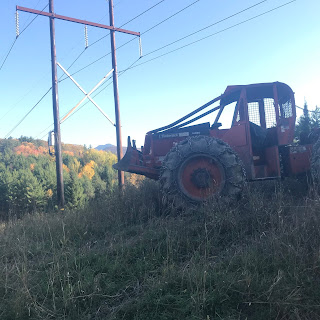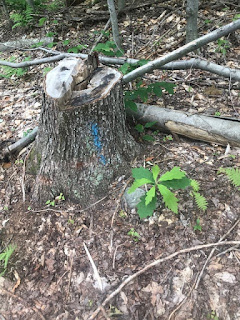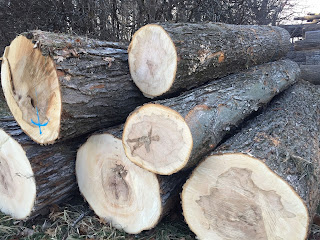ACF Update 10/15/20
Hi all,
While the
wet weather is slowing us down, we’ve been able to make progress, and just
shipped our first load of “hardwood sawlogs” this week to Canopy Timber
Alternatives in Middlebury. All of our hardwood sawlogs will be sent to Canopy,
where they will be shipped to different mills to be used for all kinds of
different things, and to LaBranche Lumber in Coventry, where they will be made
into pallets, railroad ties and crane mats. Lower-quality and smaller hardwood
trees will be processed into firewood and sold locally.
One of the strange things about forest
management is that we use logging – and logging equipment – as tools to manage
the forest. Managing the forest for its health, resilience, wildlife habitat
etc. is complicated enough, but forest management also requires foresters to
manage machines in the woods, which, if improperly managed, can undermine the
important work that we’re trying to do. Forestry trails (“skid trails” or “skid
roads”) are the way that logging equipment (in this case a “skidder” and a
“forwarder”) accesses and pulls trees out of the woods. Like the roads and
highways that we all drive cars on, they require special measures to make sure
that they’re stable. Negative impacts from skid trails that we want to avoid
are:
1. Root damage to trees adjacent to logging trails. While some surficial soil disturbance is fine (and we are actually trying to create some “scarification” to encourage certain species of trees) we want to avoid deep ruts;
2. Soil compaction. Soil compaction can
damage tree roots of existing trees and lower the fertility of soils, affecting
future generations of trees. By using existing trails (where soils have already
been compacted) and keeping logging equipment on main trails as much as
possible, we will dramatically lower the chance of soil compaction at the ACF.
The type of skidder we are using is called a “cable skidder,” which means that
it is the lightest logging equipment available, and it has a powerful winch
which allows it to drag trees to main trails, rather than needing to drive up
to every tree;
3. Erosion. We want forest management
roads and trails which are stable and which we can use again and again as we
manage the Andrews Community Forest. Forestry roads and trails which are
improperly stabilized can cause water to channelize on the surface of the
trail, gullying and “washing it out.” This means that we lose the use of
trails, either needing to pay a bunch of money to repair them or needing to
establish new ones the next time we want to manage the ACF;
4. Siltation. In addition to ruining our
infrastructure, erosion from logging trails can wash soil particles into
streams and waterways. Siltation degrades aquatic habitat for a variety of
organisms and can lead to downstream pollution, as soil particles are bonded
with nutrients like phosphorus that pollute our streams and lakes.
Managing
logging equipment requires thoughtfulness and planning – even more so when
soils are not frozen. While it might be easier to do this work in the winter,
when soils are frozen, we’re doing this work in the fall intentionally, so that
we can cause some scarification, take advantage of a great acorn and pine cone
year and bury acorns. I made a video about this and posted to my YouTube
Channel, here: https://www.youtube.com/watch?v=ERlPKomndD4 . When soils are wet the logger will need to
take time off until soils dry, unless there are opportunities to spread work
around areas where soils are drier. Luckily, soils in the ACF are generally
well-drained and dry, with the exception of the main trail between the landing
and the woods. Because this trail is stable, has good drainage and isn’t
running through the woods, we can use is when it’s a little bit wetter. A lot
of mud on this trail is not ideal, but a little mud is OK, providing that no
erosion, siltation or significant damage to the trail is occurring. Throughout this project, we will be adhering
to the Acceptable Management Practices for maintaining water quality on logging
jobs in Vermont (AMP’s), which are a set of standards designed to keep logging
trails and roads stable and avoid polluting our waterways, You can read the
AMP’s here:
https://fpr.vermont.gov/sites/fpr/files/Forest_and_Forestry/Forest_Management/Library/FullDocument-7.29.pdf
I’m
continuing to post short update videos on my YouTube channel. My most recent
one can be found here: https://youtu.be/8-v1XobvDvM . Stay tuned for more
videos and recordings of virtual events about the work at the ACF on the
Andrews Community Forest playlist on the Chittenden County Forester YouTube
channel, here: https://www.youtube.com/playlist?list=PLWk3DKdWmNIb5VOql7MqxJ09GqXg0kPVl,
including recordings of our past virtual events.
Follow
along throughout the project on Front Porch Forum, ACF's Facebook page
(https://www.facebook.com/AndrewsCommunityForest), by joining my email list -
send an email to ethan.tapper to join.



Comments
Post a Comment